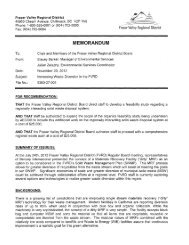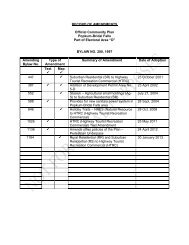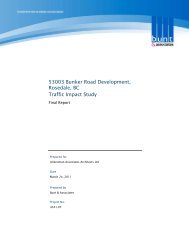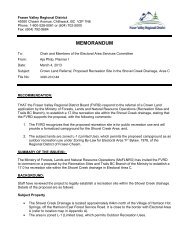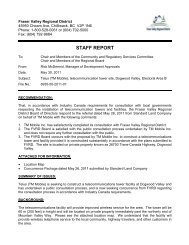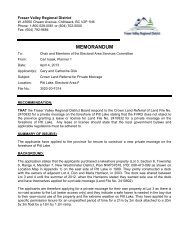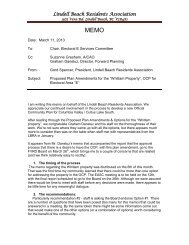Cultus Lake Park Sanitary Sewer Infrastructure Assessment
Cultus Lake Park Sanitary Sewer Infrastructure Assessment
Cultus Lake Park Sanitary Sewer Infrastructure Assessment
You also want an ePaper? Increase the reach of your titles
YUMPU automatically turns print PDFs into web optimized ePapers that Google loves.
Fraser Valley Regional District<strong>Cultus</strong> <strong>Lake</strong> <strong>Sanitary</strong> <strong>Sewer</strong> <strong>Infrastructure</strong> <strong>Assessment</strong> – Final ReportTable 10: Secondary Treatment Preliminary SizingDescription Units Option 2 Option 3Maximum Daily Design Flow (MDD) m3/day 1,893 1,893Average Dry Weather Flow m3/day 946 946Process MBBR MBRNumber of trains 2 2Train capacity m3/day 1,420 1,420Anoxic zone volume (each) m3 ? 100Anoxic zone retention timebased on annual average daily flow hr. ? 5.1based maximum day design flow hr. ? 2.5Aerobic tank volume m3 300 400Fill media m3 180 ?Aerobic tank retention timebased on annual average daily flow hr. 15.2 20.3based maximum day design flow hr. 7.6 10.1Total number of DAF units 2Total number of disc filters 2Total number of membrane modules 4Number of membrane modules per train 2Sludge concentration % 0.8?1.04.5 DisinfectionFor effluent Class A (Option 3), the effluent limits for fecal coliform is 2.2 #/100 ml(median) and 14.0 #/100 ml (any sample). For effluent Class C (Option 2), there is nolimit for fecal coliform; disinfection is not required for this option.Disinfection can be achieved using chlorine or UV disinfection.4.5.1 Ultraviolet DisinfectionUltraviolet light irradiation is an effective disinfectant. Since ultraviolet irradiation is aphysical process rather than chemical disinfection method, no toxic residuals areproduced. The major advantages of UV disinfection are its simplicity of operation, andshort contact times.The disinfection efficiency of UV irradiation depends on the degree of penetration of lightinto the micro?organisms. Suspended solids in the effluent reduce the effectiveness ofthis technology by shielding micro?organisms from the UV light. For this reason, UVirradiation is well suited to tertiary treatment plants that have effluent filters to reducesuspended solids. The major operating costs associated with this process are for powerconsumption and replacement of ultraviolet lamps. Figure 8 shows wastewater UVreactor.Project No. 30825 – September, 2012 Page 19




